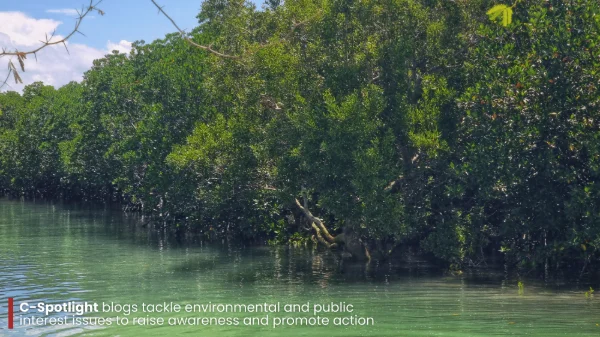The Living Bay – Debunking The Death Of Manila Bay
By: C-Help Team

Photo taken by Silina Alvarado
For many years, people have described Manila Bay in all sorts of ways - polluted, dying, forgotten. What’s there to save, right?
If you stroll by the bay in Mall of Asia, the image of a large, decaying body of water with foul smell and floating scraps and wastes of mysterious origins can openly be seen by the public.
This, I think, is the “Manila Bay” that is known by the generation now—And that’s the narrative that we want to change.
Manila Bay is not dead. In fact, it is very much alive.
Recent data from the Department of Environment and Natural Resources (DENR) indicate improvements in water quality. For instance, fecal coliform levels in certain areas have decreased significantly since the start of rehabilitation efforts. This suggests that with consistent and collective action, recovery is possible.
Moreover, studies have shown that Manila Bay still hosts diverse ecosystems, including mangrove forests and marine life, which are crucial for ecological balance. Protecting and restoring these habitats can enhance the bay's resilience against environmental threats.
In the recent 2024 cumulative impact assessment conducted by the Marine Environment and Resources Foundation (MERF), the Department of Environment and Natural Resources (DENR) confirmed that the ecosystem of Manila Bay remains vibrant.
Highlighting the importance of the cumulative impact assessment, DENR Secretary Yulo-Loyzaga stated, “It is vital for safeguarding our environment and ensuring a sustainable future. By evaluating the combined effects of various projects, we can make informed decisions that balance economic growth, social well-being, and ecosystem health.”
In an article released by the DENR, the agency said, “The MERF study evaluated the potential impacts of two ongoing, 12 approved, and seven proposed reclamation projects, focusing on water resources, ecosystems, and communities. Models for flood risk and water circulation were developed, and the group measured water quality and assessed biological resources. An interdisciplinary team of 48, including 16 oceanographers, ecologists, and planners, conducted surveys during varying seasons.”
It further stated, “The study documented 51 coral genera and 167 fish species, revealing a rich biodiversity that offers hope for future management despite the challenges. However, Dr. Charina Lyn A. Repollo warned that the proposed reclamation projects can disrupt the Bay’s natural water flow, leading to stagnation and trapping pollutants, particularly during extreme weather events, increasing water quality issues that could have far-reaching public health implications.”
We get so much protection from Manila Bay, and yet we give none to it. As citizens, it is our primary duty to take care of it or what’s left of it and let it flourish even more for the next generations and the generations yet unborn.
First, we can reduce the dependence and usage of single use plastic and plastic products in performing our daily activities. We should also support the use of plastic alternatives to lessen the waste products in Manila Bay.
Second, we should also support non-governmental organizations and other groups who are advocating for the cleanliness, protection and preservation of our natural environment.
Third, we should join and be a part of the societal and legal fight for the protection, preservation and growth of the Manila Bay and uphold and advocate the rights and challenges it experiences from the relentless misuse and abuse of corporations against it.
Lastly, we should also learn and study the very existence of Manila Bay, its function and purpose to us and our society, and its rights and struggles in order to be informed and to serve as stewards and protectors against pollution, globalization and environmental crime.
In all of this, is adding insult to injury the answer? We are of the opinion that the real problem begs for a no-brainer answer.
After all, we have, at one point in time, experienced the Manila Bay’s golden glory, that we all want to protect, preserve and redeem from what it has become in the present time.
This, in fact, has been the primary motivation of petitioners PAMALAKAYA, Kalikasan PNE, Teodoro Escarial, Romel Escarial, Oscar Benosa, Romeo Miranda, Rogelio Mendoza, Sr., Bonifacio Ilagan, Julius Villanueva, Karl Frederick Castro, Edgie Francis Uyanguren, And Alab Mirasol Ayroso, as represented by Z. Soriano & Associates Law Office (Community Legal Help and Public Interest Centre), in its Petition for the Writs of Kalikasan and Continuing Mandamus filed last December 11, 2024 with the Supreme Court.
The petition aims to stop the reclamation and seabed quarry for reclamation projects within Manila Bay in the hopes of changing the narrative—that Manila Bay is still ALIVE.
References
- Department of Environment and Natural Resources. (2019). Manila Bay Rehabilitation Program Progress Report. https://www.denr.gov.ph
- Department of Environment and Natural Resources. (2023). Manila Bay Coordinating Office Water Quality Monitoring. https://www.denr.gov.ph
- EcoWaste Coalition. (2022). Plastic pollution in Manila Bay: Reports and findings. https://ecowastecoalition.blogspot.com
- Espiritu, M. L., Santos, C. M., & De la Cruz, M. T. (2021). Microplastic contamination and microbial community response in the coastal waters of Manila Bay, Philippines. Frontiers in Environmental Science, 9, 719274. https://doi.org/10.3389/fenvs.2021.719274
- Philippine Information Agency. (2024). DENR outlines the cumulative environmental impact of reclamation in Manila Bay. https://pia.gov.ph
- Rivera, D. B., Lopez, G. S., & Reyes, J. A. (2022). Coral and seagrass habitat remnants in heavily urbanized coastal zones: Case study of Manila Bay. Science of the Total Environment, 824, 153859. https://doi.org/10.1016/j.scitotenv.2022.153859
- Supreme Court of the Philippines. (2008). Decision on G.R. Nos. 171947-48: Metropolitan Manila Development Authority, et al. vs. Concerned Residents of Manila Bay. https://elibrary.judiciary.gov.ph
- Department of Environment and Natural Resources. (2025). Manila Bay is Alive. https://denr.gov.ph/news-events/cumulative-impact-assessment-highlights/
